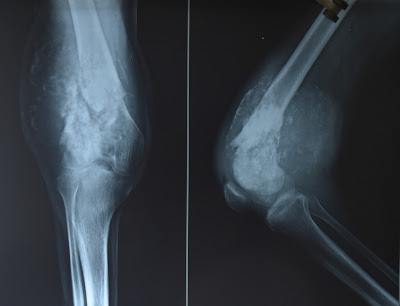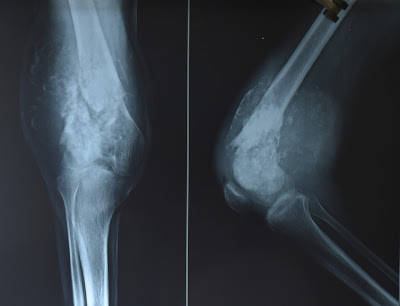What is Osteosarcoma?
Osteosarcoma (also called as Osteogenic Sarcoma ) is a type of cancer that starts in bone. It starts when bone cells grow out of control and start producing immature bone. It is the most common primary malignant bone tumour in adolescents and young adults. Despite being high grade and potentially lethal, it is highly CURABLE.
What are its symptoms?
Patient usually experiences pain and swelling around involved bone which doesn’t go or gets worse with time. Unlike mechanical pain, pain persists even at rest. Osteosarcoma occurs more commonly around knee (distal femur and proximal tibia) and shoulder (proximal Humerus) joint. Pain usually precedes swelling by few weeks. If pain persists, it should not be ignored and doctor should be consulted. Usually, patient attributes these symptoms to any antecedent trivial trauma thereby causing delay in seeking medical help which may be detrimental at times. Sometimes, pain due to osteosarcoma is mistaken for muscle soreness or “growing pains” and doctor is consulted only when the tumour has weakened the bone so much to cause a fracture (Pathological Fracture).
What causes osteosarcoma?
In majority of the patients, it is not known as to what has caused osteosarcoma though in few patients it may be attributed to prior radiation therapy, chronic osteomyelitis, Paget’s disease or some genetic alterations.
How is it diagnosed?
After proper history taking and detailed clinical examination, the patient is subjected to few blood tests, Xrays of the involved region and MRI. If these imaging tests strongly suggest some type of bone tumour, a biopsy will be needed to confirm the diagnosis. Biopsy is usually done with the help of a needle which not only is less invasive and less morbid than open biopsy but also causes lesser contamination. Once confirmed to be osteosarcoma, patient needs to undergo CT Chest along with bone scan or Whole body PET CT with CT chest for staging the disease (to confirm if the disease has already spread to other parts of the body).
In biopsy, some part of tumour tissue is removed and sent for examination under microscope. It can be open biopsy (in which a surgical incision is made to expose the tumorous bone and take out the diseased tissue) or a needle biopsy (in which a thin needle is used to take out the tissue without any incision). Since needle biopsy doesn’t involve any incision, the surgical trauma, pain and morbidity are lesser with needle biopsy.
It is very important that a biopsy should always be done by surgeon experienced with sarcomas who will be doing the definitive surgery since poorly done biopsies not only may yield false negative or inconclusive results but also wrongly placed biopsy scars can be detrimental for future limb salvage (which might unnecessarily cause increase in extent of surgery and hence the complications). In a nutshell, since the location and technical aspects of biopsy can affect the treatment options and final outcome of the patient, biopsy should always be done by Orthopaedic Oncologist or one of his team members.
We at Bone Cancer Clinic, Chandigarh do biopsy with a needle for almost all the cases with a very high diagnostic yield
How is Osteosarcoma treated?
After proper work up, patients with high grade osteosarcoma receives 2-3 months of chemotherapy (neo-adjuvant chemotherapy) followed by surgery. Surgery broadly involves removal of the diseased bone with wide margins (healthy tissue around the cancerous bone). The cancerous bone so removed is sent for examination to a dedicated musculo-skeletal Pathologist (Doctor who examines the diseased body part under microscope) to look for response to chemotherapy and also for confirming the adequacy of margins. After 2-3 weeks of surgery, the patient is restarted on chemotherapy (adjuvant chemotherapy). The total duration of treatment may range from 6-9 months.
What is chemotherapy?
Chemotherapy refers to group of anti-cancer drugs that are used to kill cancer cells. In Osteosarcoma, patient is given chemotherapy before surgery (Neo-adjuvant chemotherapy) as well as after surgery. Patient needs to be admitted in the hospital to receive chemotherapy.
What kind of surgery is performed in Osteosarcoma?
With the advent of newer surgical techniques, it is possible to do a limb salvage surgery in majority of the patients in which only the part of the bone involved with osteosarcoma is removed rather than cutting the whole limb. The defect so created is reconstructed with artificial metal implant thereby saving the limb.
In some cases, the cancerous bone so removed is given very high dose of radiation so as to kill all the cancer cells and the sterilised bone so formed is fixed back to the parent bone with the help of plates and screws, a technique commonly called as Extra Corporeal Radiation Therapy (ECRT).
The cancerous bone so removed can also be sterilised by exposing it to very cold temperatures with the help of liquid nitrogen- a technique known as Cryotherapy.
In today’s era, in some patients, bone can be sterilised with liquid nitrogen without removing it completely from the body, a technique known as Pedicled Cryotherapy
In children, since the artificial joint will not grow as the child grows leading to unequal limb lengths over a period of time, the defect can be reconstructed with an expandable joint which can be lengthened as the child grows which allows to maintain limb length equality at the time of skeletal maturity.
Occasionally, because of tumour size, location or poor response to chemotherapy, patient is offered amputation (cutting the limb) or rotationplasty. Will I still need surgery if I get a very good response to chemotherapy?
Yes. The bone involved with osteosarcoma must be surgically removed for aiming cure.
Do alternative therapies work in osteosarcoma?
Though number of people claim to cure osteosarcoma with alternative therapies but there is no scientific evidence backing those claims. Patients falling for these alternative therapies delay their actual (evidence based) treatment which may be detrimental.
Whom to consult?
First chance is the best chance when it comes to managing Osteosarcoma treatment in India or any bone cancer. Patient should consult a trained Orthopaedic Oncologist when diagnosed or suspected to have Osteosarcoma. Bone Cancer Clinic at Sector 19, Chandigarh is a centre dedicated exclusively for the management of such bone tumours.
Dr Rajat Gupta
Orthopaedic Oncologist
Bone Cancer Clinic
# 5, Sector 19 A, Chandigarh
https://goo.gl/maps/KT5hkxsRVy12
SCO 141 (Backside), Sector 14, Panchkula
https://goo.gl/maps/aLdmMwMqvMumVXe76


